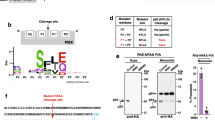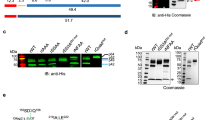Abstract
Newly replicated Plasmodium falciparum parasites escape from host erythrocytes through a tightly regulated process that is mediated by multiple classes of proteolytic enzymes. However, the identification of specific proteases has been challenging. We describe here a forward chemical genetic screen using a highly focused library of more than 1,200 covalent serine and cysteine protease inhibitors to identify compounds that block host cell rupture by P. falciparum. Using hits from the library screen, we identified the subtilisin-family serine protease PfSU B1 and the cysteine protease dipeptidyl peptidase 3 (DPAP3) as primary regulators of this process. Inhibition of both DPAP3 and PfSUB1 caused a block in proteolytic processing of the serine repeat antigen (SERA) protein SERA5 that correlated with the observed block in rupture. Furthermore, DPAP3 inhibition reduced the levels of mature PfSUB1. These results suggest that two mechanistically distinct proteases function to regulate processing of downstream substrates required for efficient release of parasites from host red blood cells.
This is a preview of subscription content, access via your institution
Access options
Subscribe to this journal
Receive 12 print issues and online access
$259.00 per year
only $21.58 per issue
Buy this article
- Purchase on Springer Link
- Instant access to full article PDF
Prices may be subject to local taxes which are calculated during checkout







Similar content being viewed by others
References
Carruthers, V.B. & Blackman, M.J. A new release on life: emerging concepts in proteolysis and parasite invasion. Mol. Microbiol. 55, 1617–1630 (2005).
O'Donnell, R.A. & Blackman, M.J. The role of malaria merozoite proteases in red blood cell invasion. Curr. Opin. Microbiol. 8, 422–427 (2005).
Rosenthal, P.J. Cysteine proteases of malaria parasites. Int. J. Parasitol. 34, 1489–1499 (2004).
Wickham, M.E., Culvenor, J.G. & Cowman, A.F. Selective inhibition of a two-step egress of malaria parasites from the host erythrocyte. J. Biol. Chem. 278, 37658–37663 (2003).
Harris, P.K. et al. Molecular identification of a malaria merozoite surface sheddase. PLoS Pathog. 1, 241–251 (2005).
Green, J.L., Hinds, L., Grainger, M., Knuepfer, E. & Holder, A.A. Plasmodium thrombospondin related apical merozoite protein (PTRAMP) is shed from the surface of merozoites by PfSUB2 upon invasion of erythrocytes. Mol. Biochem. Parasitol. 150, 114–117 (2006).
Li, J., Mitamura, T., Fox, B.A., Bzik, D.J. & Horii, T. Differential localization of processed fragments of Plasmodium falciparum serine repeat antigen and further processing of its N-terminal 47 kDa fragment. Parasitol. Int. 51, 343–352 (2002).
Howell, S.A. et al. Distinct mechanisms govern proteolytic shedding of a key invasion protein in apicomplexan pathogens. Mol. Microbiol. 57, 1342–1356 (2005).
Aly, A.S. & Matuschewski, K. A malarial cysteine protease is necessary for Plasmodium sporozoite egress from oocysts. J. Exp. Med. 202, 225–230 (2005).
Miller, S.K. et al. A subset of Plasmodium falciparum SERA genes are expressed and appear to play an important role in the erythrocytic cycle. J. Biol. Chem. 277, 47524–47532 (2002).
Li, J., Matsuoka, H., Mitamura, T. & Horii, T. Characterization of proteases involved in the processing of Plasmodium falciparum serine repeat antigen (SERA). Mol. Biochem. Parasitol. 120, 177–186 (2002).
Aoki, S. et al. Serine repeat antigen (SERA5) is predominantly expressed among the SERA multigene family of Plasmodium falciparum, and the acquired antibody titers correlate with serum inhibition of the parasite growth. J. Biol. Chem. 277, 47533–47540 (2002).
Pang, X.L., Mitamura, T. & Horii, T. Antibodies reactive with the N-terminal domain of Plasmodium falciparum serine repeat antigen inhibit cell proliferation by agglutinating merozoites and schizonts. Infect. Immun. 67, 1821–1827 (1999).
Blackman, M.J. Purification of Plasmodium falciparum merozoites for analysis of the processing of merozoite surface protein-1. Methods Cell Biol. 45, 213–220 (1994).
Contreras, C.E. et al. Stage-specific activity of potential antimalarial compounds measured in vitro by flow cytometry in comparison to optical microscopy and hypoxanthine uptake. Mem. Inst. Oswaldo Cruz 99, 179–184 (2004).
Powers, J.C., Asgian, J.L., Ekici, O.D. & James, K.E. Irreversible inhibitors of serine, cysteine, and threonine proteases. Chem. Rev. 102, 4639–4750 (2002).
Jackson, K.E. et al. Selective permeabilization of the host cell membrane of Plasmodium falciparum-infected red blood cells with streptolysin O and equinatoxin II. Biochem. J. 403, 167–175 (2007).
Saliba, K.J. & Kirk, K. Nutrient acquisition by intracellular apicomplexan parasites: staying in for dinner. Int. J. Parasitol. 31, 1321–1330 (2001).
Nyalwidhe, J. et al. A nonpermeant biotin derivative gains access to the parasitophorous vacuole in Plasmodium falciparum-infected erythrocytes permeabilized with streptolysin O. J. Biol. Chem. 277, 40005–40011 (2002).
Sajid, M., Withers-Martinez, C. & Blackman, M.J. Maturation and specificity of Plasmodium falciparum subtilisin-like protease-1, a malaria merozoite subtilisin-like serine protease. J. Biol. Chem. 275, 631–641 (2000).
Jean, L., Withers-Martinez, C., Hackett, F. & Blackman, M.J. Unique insertions within Plasmodium falciparum subtilisin-like protease-1 are crucial for enzyme maturation and activity. Mol. Biochem. Parasitol. 144, 187–197 (2005).
Blackman, M.J. et al. A subtilisin-like protein in secretory organelles of Plasmodium falciparum merozoites. J. Biol. Chem. 273, 23398–23409 (1998).
Yeoh, S. et al. Subcellular discharge of a serine protease mediates release of invasive malaria parasites from host erythrocytes. Cell 131, 1072–1083 (2007).
Shenai, B.R., Sijwali, P.S., Singh, A. & Rosenthal, P.J. Characterization of native and recombinant falcipain-2, a principal trophozoite cysteine protease and essential hemoglobinase of Plasmodium falciparum. J. Biol. Chem. 275, 29000–29010 (2000).
Sijwali, P.S., Shenai, B.R., Gut, J., Singh, A. & Rosenthal, P.J. Expression and characterization of the Plasmodium falciparum haemoglobinase falcipain-3. Biochem. J. 360, 481–489 (2001).
Sijwali, P.S. & Rosenthal, P.J. Gene disruption confirms a critical role for the cysteine protease falcipain-2 in hemoglobin hydrolysis by Plasmodium falciparum. Proc. Natl. Acad. Sci. USA 101, 4384–4389 (2004).
Sijwali, P.S., Koo, J., Singh, N. & Rosenthal, P.J. Gene disruptions demonstrate independent roles for the four falcipain cysteine proteases of Plasmodium falciparum. Mol. Biochem. Parasitol. 150, 96–106 (2006).
Kam, C.M. et al. Design and evaluation of inhibitors for dipeptidyl peptidase I (Cathepsin C). Arch. Biochem. Biophys. 427, 123–134 (2004).
Klemba, M., Gluzman, I. & Goldberg, D.E. A Plasmodium falciparum dipeptidyl aminopeptidase I participates in vacuolar hemoglobin degradation. J. Biol. Chem. 279, 43000–43007 (2004).
Yuan, F., Verhelst, S.H., Blum, G., Coussens, L.M. & Bogyo, M. A selective activity-based probe for the papain family cysteine protease dipeptidyl peptidase I/cathepsin C. J. Am. Chem. Soc. 128, 5616–5617 (2006).
Greenbaum, D.C. et al. A role for the protease falcipain 1 in host cell invasion by the human malaria parasite. Science 298, 2002–2006 (2002).
Wang, G., Mahesh, U., Chen, G.Y. & Yao, S.Q. Solid-phase synthesis of peptide vinyl sulfones as potential inhibitors and activity-based probes of cysteine proteases. Org. Lett. 5, 737–740 (2003).
Delplace, P., Fortier, B., Tronchin, G., Dubremetz, J.F. & Vernes, A. Localization, biosynthesis, processing and isolation of a major 126 kDa antigen of the parasitophorous vacuole of Plasmodium falciparum. Mol. Biochem. Parasitol. 23, 193–201 (1987).
Delplace, P. et al. Protein p126: a parasitophorous vacuole antigen associated with the release of Plasmodium falciparum merozoites. Biol. Cell 64, 215–221 (1988).
Tallarida, R.J. Drug synergism: its detection and applications. J. Pharmacol. Exp. Ther. 298, 865–872 (2001).
Withers-Martinez, C. et al. Expression of recombinant Plasmodium falciparum subtilisin-like protease-1 in insect cells. Characterization, comparison with the parasite protease, and homology modeling. J. Biol. Chem. 277, 29698–29709 (2002).
Henningsson, F., Wolters, P., Chapman, H.A., Caughey, G.H. & Pejler, G. Mast cell cathepsins C and S control levels of carboxypeptidase A and the chymase, mouse mast cell protease 5. Biol. Chem. 384, 1527–1531 (2003).
Hodder, A.N. et al. Enzymic, phylogenetic, and structural characterization of the unusual papain-like protease domain of Plasmodium falciparum SERA5. J. Biol. Chem. 278, 48169–48177 (2003).
Hackett, F., Sajid, M., Withers-Martinez, C., Grainger, M. & Blackman, M.J. PfSUB-2: a second subtilisin-like protein in Plasmodium falciparum merozoites. Mol. Biochem. Parasitol. 103, 183–195 (1999).
Palmer, J.T., Rasnick, D., Klaus, J.L. & Bromme, D. Vinyl sulfones as mechanism-based cysteine protease inhibitors. J. Med. Chem. 38, 3193–3196 (1995).
Delplace, P., Dubremetz, J.F., Fortier, B. & Vernes, A. A 50 kilodalton exoantigen specific to the merozoite release-reinvasion stage of Plasmodium falciparum. Mol. Biochem. Parasitol. 17, 239–251 (1985).
Acknowledgements
The authors thank M. Blackman (UK National Institute for Medical Research) for sharing his data on SERA5 processing before its publication and for providing reagents for PfSUB1. We also thank M. Klemba (Virginia Tech) for valuable information about the DPAPs and the DPAP1-specific antibodies. We thank J. Powers (University of Georgia) and W. Roush (The Scripps Research Institute) for the directed irreversible inhibitors of serine and cysteine proteases. We thank J.-F. Dubremetz (Université de Montpellier 2) for providing the SERA5-specific antibody. We thank C. Yang for generating compound toxicity data, S. Verhelst for analysis of NMR data and A. Guzzetta for high-resolution mass spectrometry analysis of compounds. This work was supported by funding from the Kinship Foundation as part of the Searle Scholars program (to M.B.), from a Burroughs Wellcome Trust New Investigators in Pathogenesis Award (to M.B.) and by the US National Institutes of Health National Technology Center for Networks and Pathways grants U54 RR020843 and R01 EB005011 (to M.B.). S.A.K. is supported by the US National Institutes of Health Research Fellowship Award F32 AI069728-01A1. E.L.P. is supported by the US National Science Foundation Graduate Research Fellowship 2005021299. C.I.P. is supported by an American Society for Microbiology Watkins Fellowship.
Author information
Authors and Affiliations
Corresponding author
Supplementary information
Supplementary Text and Figures
Supplementary Figures 1–7 and Supplementary Methods (PDF 2372 kb)
Rights and permissions
About this article
Cite this article
Arastu-Kapur, S., Ponder, E., Fonović, U. et al. Identification of proteases that regulate erythrocyte rupture by the malaria parasite Plasmodium falciparum. Nat Chem Biol 4, 203–213 (2008). https://doi.org/10.1038/nchembio.70
Received:
Accepted:
Published:
Issue Date:
DOI: https://doi.org/10.1038/nchembio.70
This article is cited by
-
Characteristic features of the SERA multigene family in the malaria parasite
Parasites & Vectors (2020)
-
The parasitophorous vacuole of the blood-stage malaria parasite
Nature Reviews Microbiology (2020)
-
Calculations of Geometric Parameters and Physicochemical Properties of Complexes Formed of FE(II)-Reactive 1,2,4-Trioxolane Ring and Some Anti-Malaria Drugs Via Traceless Linker
Pharmaceutical Chemistry Journal (2019)
-
An in vivo multiplexed small-molecule screening platform
Nature Methods (2016)
-
1H, 13C and 15N resonance assignments and secondary structure analysis of CmPI-II, a serine protease inhibitor isolated from marine snail Cenchritis muricatus
Biomolecular NMR Assignments (2016)



